Farming sector reforms and modernization key to economic growth, poverty alleviation, experts from India say
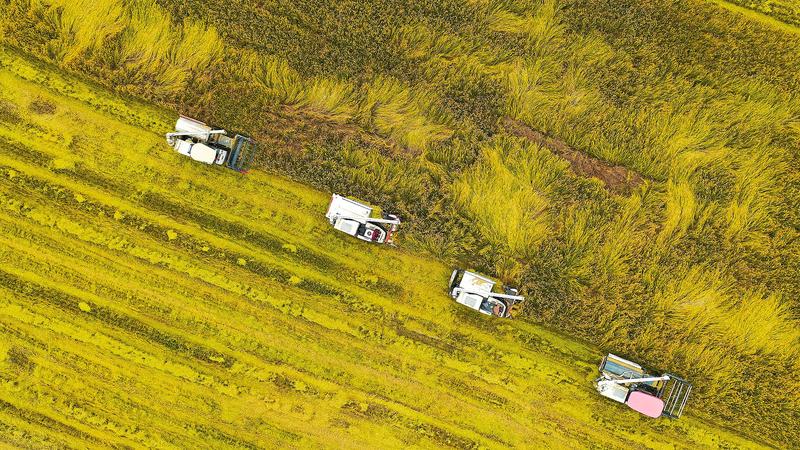 Farmers harvest rice in Deqing, Zhejiang province, in October. (WANG ZHENG / FOR CHINA DAILY)
Farmers harvest rice in Deqing, Zhejiang province, in October. (WANG ZHENG / FOR CHINA DAILY)
As China presses ahead with national rejuvenation, economists, academicians and analysts from India who have visited the country believe that rapid agricultural development has been key to laying the foundation for unprecedented economic progress.
Despite China's huge population, limited agricultural land and scarcity of water, in recent decades the nation has achieved significant agricultural productivity growth through land reform, technological innovation, market reforms and public investment in rural infrastructure, the experts said.
China has also ensured rapid enhancement of agricultural productivity to feed its 1.4 billion people, they added.
The experts attributed the nation's advances to modern technologies, meticulous farming methods, well-managed land resources, standardized agricultural production, biotechnology, artificial intelligence, environmental protection and the agricultural sector's market transformation.
Praising China's outstanding agricultural development, the Indian experts said the country witnessed remarkable growth after rural reform policies were outlined in 1979.
Since then, the Chinese leadership had devised farsighted multipronged strategies to address the main challenges posed to agriculture and rural development. It has also drawn up key initiatives to ensure food security. As a result, the nation is reaping the dividends from these measures.
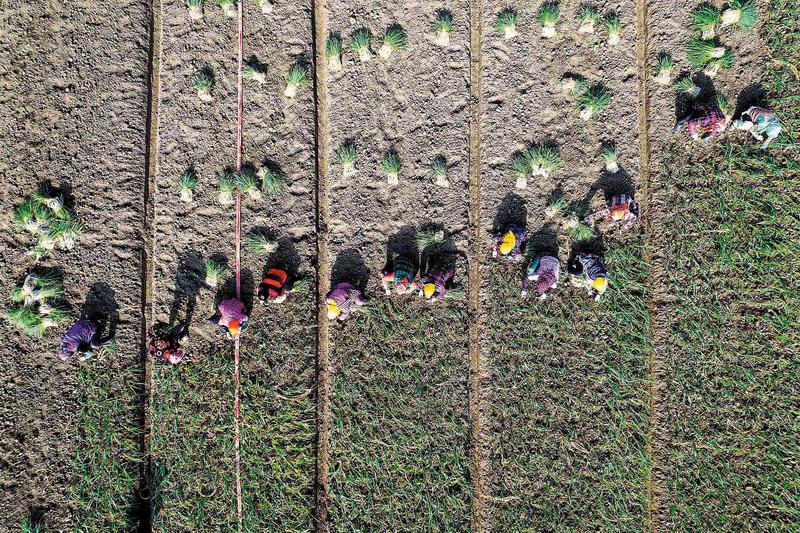 Green onions are grown in Lingdong village, Xinghua city, Jiangsu province. (TANG DEHONG / FOR CHINA DAILY)
Green onions are grown in Lingdong village, Xinghua city, Jiangsu province. (TANG DEHONG / FOR CHINA DAILY)
Economist R. Ramakumar, a professor at the Tata Institute of Social Sciences in Mumbai, said China's rural reform policies have been linked to unmatched progress in poverty alleviation and have led to significant improvements in education and health for the rural population.
Meanwhile, agricultural growth has also contributed significantly to industrial sector expansion through resource transfers.
Ramakumar, who has visited China many times, said the reforms introduced since 1978 cannot be equated to embracing the Washington Consensus. This set of policy recommendations for developing nations was agreed upon by Western countries, particularly the United States, and global development institutions such as the World Bank and the International Monetary Fund. The recommendations became popular during the 1980s.
Post-1978 policy changes in agriculture were driven by the Marxist dictum of ensuring harmony between the relations of production and the forces of production, which led to the fundamentally socialist characteristics of Chinese agriculture being preserved, Ramakumar said.
Even under the household responsibility system, land was still collectively owned, and production was under contract. Collectives continued to manage plowing, seeding, irrigation and water conservation on farms, while farmers continued to contribute to the collective accumulation fund, which was used for public investment in rural infrastructure, he added.
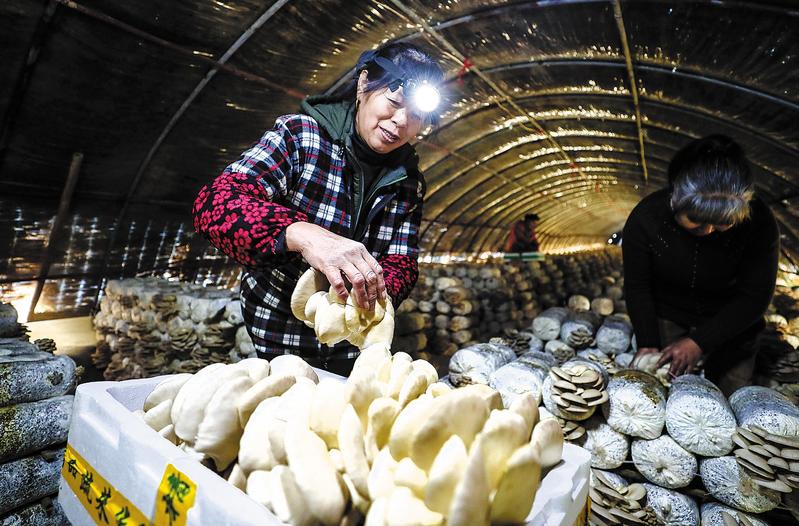 Farmers sort mushrooms in Xiayang village, Deqing, Zhejiang. (WANG ZHENG / FOR CHINA DAILY)
Farmers sort mushrooms in Xiayang village, Deqing, Zhejiang. (WANG ZHENG / FOR CHINA DAILY)
Spending rises
Spending on agriculture by the Chinese government rose from 235.8 billion yuan in 2004 to 2.1 trillion yuan in 2019.
As a result, damage to crop-growing areas from natural disasters during this period fell by 48.1 percent, while the contribution of scientific and technological progress to agricultural output rose from 45 percent to 59.2 percent, according to the National Development and Reform Commission and the Ministry of Agriculture and Rural Affairs.
At the same time, farming, livestock and fisheries production increased significantly.
The experts noted that China launched its economic reforms in 1978 by first turning to agriculture. The nation dismantled its commune system of landholdings and also liberated agricultural markets, allowing farmers to get much higher prices for their produce.
Ashok Gulati, a noted Indian agricultural economist who has visited China many times since the 1980s, said that in the six years from 1978, Chinese farmers' incomes rose by nearly 14 percent annually, more than doubling during this time and triggering reforms in other sectors.
A report prepared by Gulati and another Indian scholar, Prerna Terway, shows that in 2019, China's agricultural output stood at $1.37 trillion, compared with $407 billion for India. China has also invested heavily in research and development related to farming practices.
Gulati said China's agricultural output is three times that of India and comes from a smaller arable area-119 million hectares compared with India's 156 million hectares.
From 1978 to 2002, China's agricultural growth nearly doubled that from 1966 to 1977. This was the main reason poverty affected just 3 percent of the population in 2001, down from 33 percent in 1978, according to a report published by Gulati and Chinese agricultural scholar Shenggen Fan in 2008 in the Indian publication Economic and Political Weekly.
Fan and Gulati were both associated with the International Food Policy Research Institute at that time.
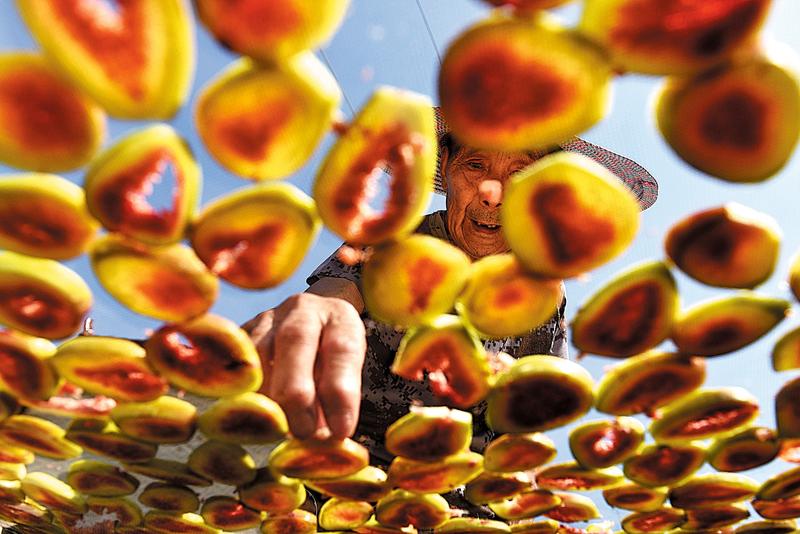 A farmer dries figs in Guangming village, Neijiang city, Sichuan province, in July. (HUANG ZHENGHUA / FOR CHINA DAILY)
A farmer dries figs in Guangming village, Neijiang city, Sichuan province, in July. (HUANG ZHENGHUA / FOR CHINA DAILY)
They said in the report: "By making agriculture-a sector which gives the majority of people their livelihoods-the starting point of market-oriented reforms, China could ensure widespread distribution of grain and build consensus and political support for the continuation of reforms.
"Reform of incentives resulted in greater returns for farmers and in more efficient resource allocation, which in turn strengthened the domestic production base and made it more competitive."
Saikiran Kannan, a columnist and analyst who visited China in 2014, said another important reason for the nation's greater efficiency and diversity in its agricultural practices is that farmers have the incentive to grow different crops based on the type of land used and the season.
China's highly advanced e-commerce sector has also enabled the nation's farmers to sell their produce directly to consumers worldwide, while community supported agriculture enables purchases to be made directly from a farmer or a group of farmers, Kannan said.
According to the UN Food and Agricultural Organization, or FAO, China has succeeded in producing 25 percent of the world's grain and feeding 20 percent of the global population from less than 10 percent of the world's arable land, which it said is a great achievement.
The nation ranks first in the world for production of cereals, cotton, fruit, vegetables, meat, poultry, eggs and fishery products, and in providing assistance to other developing countries to support local agricultural development, the FAO said.
Digital technologies have enabled Chinese farmers to better equip themselves to face new challenges and to make their businesses more profitable and efficient, experts said.
Sudheendra Kulkarni, who served as an aide to former Indian prime minister Atal Bihari Vajpayee from 1998 to 2004, said that since pro-market economic reforms were introduced in the late 1970s, China has freed 800 million people from poverty.
Kulkarni is also founder of the Forum for a New South Asia, which champions a peaceful and prosperous South Asian subcontinent based on cooperation between China, India and Pakistan.
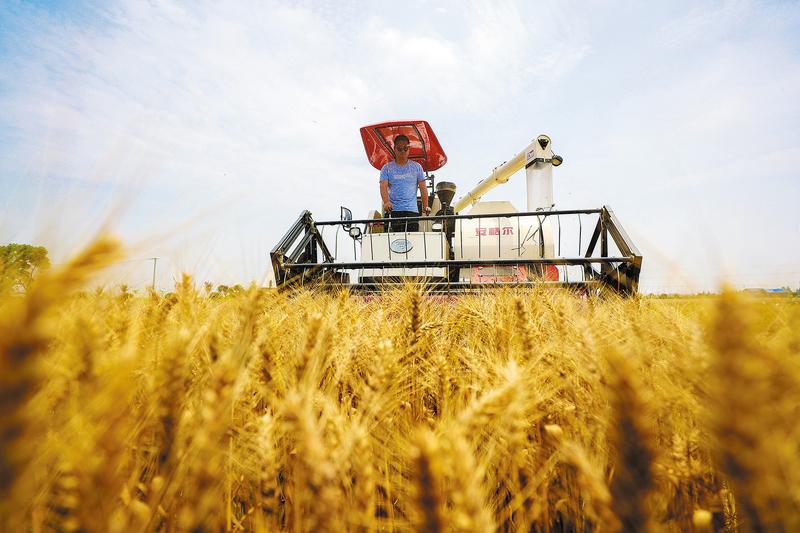 Wheat is harvested in Hemu village, Deqing, Zhejiang. (WANG ZHENG / FOR CHINA DAILY)
Wheat is harvested in Hemu village, Deqing, Zhejiang. (WANG ZHENG / FOR CHINA DAILY)
Complete victory
In February last year, China declared it has secured a complete victory in its fight against poverty. The country had achieved the UN goal of poverty eradication 10 years ahead of the 2030 deadline.
In China, anyone in a rural area earning less than about $2.30 a day is defined as impoverished. The World Bank's poverty line is $1.90 a day.
In 1980, China's per capita GDP was just over $200, but it now stands at about $10,000. The World Bank has acknowledged that the nation is responsible for more than 70 percent of the global reduction in poverty over the past four decades.
Kulkarni said no country has lifted so many people out of poverty in such a short time, adding that Xi has made more than 80 visits to rural areas in eight years to inspect his anti-poverty campaign.
From 1978 to 2018, China's GDP grew at an average annual rate of 9.4 percent, according to the FAO and the National Bureau of Statistics. The Chinese economy is now 37 times larger than it was in 1978, when the nation launched its reform efforts. As a result, by 2011, China had become the world's second-largest economy.
Nilotpal Basu, a former member of the Indian parliament and a politburo member of the Communist Party of India (Marxist), said China has achieved substantial progress in the structural transformation of the agricultural sector.
This is due to increasingly popular diversified management, better use of land resources, a higher proportion of high value-added farm produce and the introduction of technology-intensive agricultural goods, according to Basu.
In many countries, farmers need to spend more on agriculture than they earn from their produce, but China has addressed this problem to a great extent by making use of modern technology, Basu added.
The writer is a freelance journalist for China Daily.



